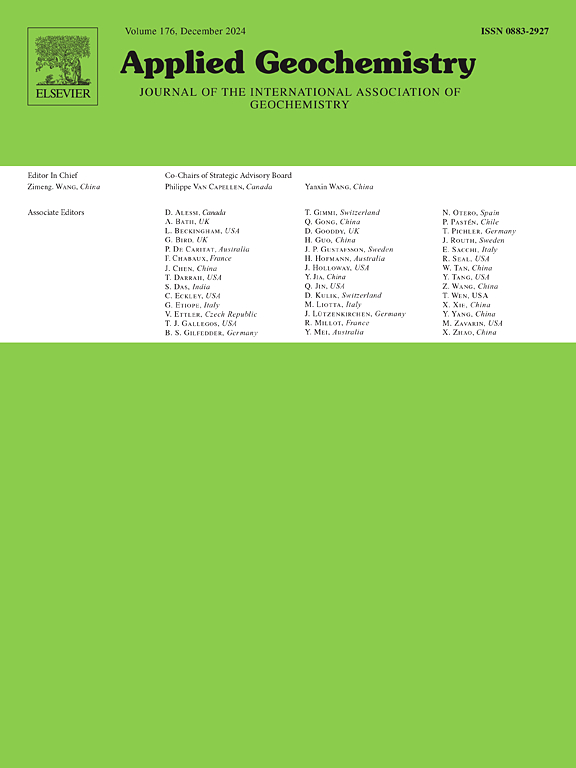Reactive transport modeling of CO2 and CH4 plumes during a gas-rich water leakage in a shallow carbonate freshwater aquifer
IF 3.4
3区 地球科学
Q1 GEOCHEMISTRY & GEOPHYSICS
引用次数: 0
Abstract
The recent advances in geological carbon capture and storage and the worldwide proliferation of such projects to reach net-zero emissions by 2050 highlight the importance of investigating the risks associated with CO2 leakage from carbon storage reservoirs into shallow aquifers. A recent experiment indicates that residual CH4 from legacy hydrocarbon fields could be a potential early indicator of CO2 leakage. In this study, numerical reactive transport simulations are performed to examine the reasons behind the different behavior of CH4 in regard to CO2 as well as its potential and limitations as a monitoring parameter. The base case model was calibrated using a large data set, including a tracer test, major element concentrations, dissolved CO2 and CH4 concentrations, and pH monitoring.
The results show that the delay of CO2 with respect to CH4 is likely related to sorption, which plays a significant role in CO2 retardation but has a minimal effect on CH4 transport. The presence of clay minerals (montmorillonite and illite) did not significantly change the delay between the two gases. Furthermore, CO2 retardation was found to increase in a scenario with a lower natural groundwater CO2 concentration. The CH4 oxidation simulation revealed that oxidation decreased the CH4 concentration below the CH4 concentrations from baseline water reported in the literature, suggesting that CH4 oxidation is a critical process able to reduce the efficiency of CH4 monitoring and should be considered if CH4 monitoring is implemented.
浅层碳酸盐岩淡水含水层富气水泄漏过程中CO2和CH4羽流的反应输运模拟
地质碳捕获和封存方面的最新进展,以及到2050年实现净零排放的此类项目在世界范围内的扩散,突显了调查二氧化碳从碳储存库泄漏到浅层含水层的风险的重要性。最近的一项实验表明,遗留烃田的残余CH4可能是CO2泄漏的潜在早期指标。在本研究中,进行了数值反应输运模拟,以研究CH4相对于CO2的不同行为背后的原因,以及它作为监测参数的潜力和局限性。使用大型数据集校准基本情况模型,包括示踪剂测试、主要元素浓度、溶解CO2和CH4浓度以及pH监测。结果表明,CO2相对于CH4的延迟可能与吸附有关,吸附在CO2延迟中起重要作用,但对CH4运输的影响很小。粘土矿物(蒙脱石和伊利石)的存在并没有显著改变两种气体之间的延迟。此外,在天然地下水CO2浓度较低的情况下,CO2迟滞现象增加。CH4氧化模拟显示,氧化使CH4浓度低于文献中报道的基线水的CH4浓度,这表明CH4氧化是一个能够降低CH4监测效率的关键过程,如果实施CH4监测应予以考虑。
本文章由计算机程序翻译,如有差异,请以英文原文为准。
求助全文
约1分钟内获得全文
求助全文
来源期刊

Applied Geochemistry
地学-地球化学与地球物理
CiteScore
6.10
自引率
8.80%
发文量
272
审稿时长
65 days
期刊介绍:
Applied Geochemistry is an international journal devoted to publication of original research papers, rapid research communications and selected review papers in geochemistry and urban geochemistry which have some practical application to an aspect of human endeavour, such as the preservation of the environment, health, waste disposal and the search for resources. Papers on applications of inorganic, organic and isotope geochemistry and geochemical processes are therefore welcome provided they meet the main criterion. Spatial and temporal monitoring case studies are only of interest to our international readership if they present new ideas of broad application.
Topics covered include: (1) Environmental geochemistry (including natural and anthropogenic aspects, and protection and remediation strategies); (2) Hydrogeochemistry (surface and groundwater); (3) Medical (urban) geochemistry; (4) The search for energy resources (in particular unconventional oil and gas or emerging metal resources); (5) Energy exploitation (in particular geothermal energy and CCS); (6) Upgrading of energy and mineral resources where there is a direct geochemical application; and (7) Waste disposal, including nuclear waste disposal.
 求助内容:
求助内容: 应助结果提醒方式:
应助结果提醒方式:


